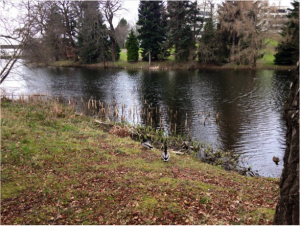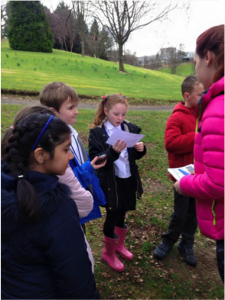Understanding the Needs of Wild Birds

Our geocache is * located by the loch-side, in an open green space, (with a wide view of the loch and its surrounding environment) and a short walk from the Airthrey Loch bridge. The main focus of the geocache activities are about water based habitats and conservation, thus, the clear view around the open space assists the children in their tasks from this location.
One of the main purposes for the geocache was to influence learning about the wild birds on the loch. For the children to understand the needs of the birds, they identified the wildlife as part of their first task. We have included an activity pack for children to use to help with this, using laminated identification cards. In the second task, the children had to question what would be more important, building a renewable energy plant or protecting the vulnerable species on the loch. This activity prompted a discussion between the children using open questions, again included with the geocache on laminated card and a talking stick was in place in the box to allow the children to take turns to talk and go over their opinions in their group. It also provided the group with a way to listen to others and work on their communication skills.
This geocache allows the children to work in a group setting but also to apply their prior scientific knowledge of renewable energy and biodiversity. The children were particularly engaged n this activity, which could be because of the real life context through which they were learning. They also developed their identification skills and their understanding of water based habitats by identifying as many water birds as they could. These activities allowed children to discuss the need for conservation and protection of flora and fauna through a real life context that exploited the interconnected nature of science and the science curriculum within the Curriculum for Excellence. This geocache also promotes Learning for Sustainability, as the children are encouraged to think about how humans effect the environment.

“Learning for sustainability (LfS) is concerned with knowing and understanding our world and about equipping children and young people with values, knowledge, attitudes, capabilities and skills to enable them to contribute effectively to the common good.”
The landscape around the geocache has a number of benefits. Personalisation and choice were key in this task and children chose who they worked with and where they worked in the area, they also identified hazards and the risks they posed as well as ways to manage those risks. The questions allowed them to work at their own pace. As the activities contained in the geocache could not be completed just anywhere, but instead relied on the location of the cache. The learning that took place was ‘place essential’ this provided an opportunity to connect with the landscape and its wildlife that might not have been available had we included a different task.
Throughout the geocache the children must consider some big questions regarding the value of outdoor spaces. In the second activity, they needed to use the scenario cue, to question how to conserve and maintain sufficient renewable energy, providing a sustainability ethos about the geocache. It is hoped that through discussion and further questioning children will employ high order thinking skills to critically evaluate ways to protect, conserve and sustain outdoor places.

Amy, Rebecca, Kasia (Edu9S6 2016 – University of Stirling Students – Primary Eduction – Environment Specialism)
* This geocache was a temporary installation as part of the students’ work on a university module within the primary teacher education environment specialism pathway and is not available on geocaching.com

